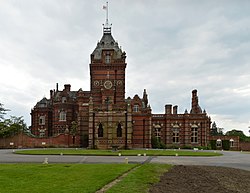Elvetham Hall
| Elvetham Hall | |
| Hampshire | |
|---|---|
 Elvetham Hall | |
| Location | |
| Grid reference: | SU78205639 |
| Location: | 51°18’5"N, -0°52’47"W |
| Village: | Hartley Wintney |
| History | |
| Built 1859 – 1862 | |
| By: | Samuel Sanders Teulon |
| Country house | |
| Gothic Revival | |
| Information | |
| Website: | elvethamhotel.co.uk |
Elvetham Hall is a country house in Hampshire which is now a hotel. It is to be found in the parish of Hartley Wintney about two miles north-west of Fleet.
The building is a High Victorian Gothic Revival house and a Grade II* listed building.[1] It stands in a landscaped park that is Grade II listed.[2]
Architecture
The house was built in 1859–62[1] for Frederick Gough, 4th Baron Calthorpe.[3] It was designed by Samuel Sanders Teulon, who was noted for his polychrome brickwork. It is built of red brick and stone dressing, with bands and decoration in black brick. It is an ornate design with hipped and mansard roofs with gables and dormers, tall brick chimneys and an entrance front dominated by a tall tower. The interior is notable for its fireplaces.
The house has a porte-cochère that was added in 1901 and a dining room that was added in 1911. Both are designed "deceivingly" to match the original house.[4]
The architectural historians Nikolaus Pevsner and David Lloyd called Elvetham Hall "A major house of [Teulon], but not one anybody would praise for beauty".[3] Another architectural historian, Mark Girouard, called it "the holiest or unholiest of zebras, being not only striped, but also zigzagged and diapered all over with bricks, and slates of different colours... like an enormous multi-coloured jelly".[5]
Estate
The 300-acre Elvetham estate was established by Sir William Sturmy in 1403 after inheriting the possessions of his uncle Sir Henry Sturmy in 1381. He died there in 1427 and the estate, along with his main seat at Wulfhall in Wiltshire, passed to his son-in-law John Seymour. It passed down in the Seymour family and was visited by Elizabeth I, who planted an oak tree that still stands in the park.
The estate passed to the Calthorpe family in the middle of the 17th century. The original manor house burnt down in 1840.[6]

A Church of England parish church was built on the estate in 1840–41. It is in Norman revival style and faced with flint. It has a broach spire that may have been added by Teulon.[7] The church is east of the current house. It is no longer used for worship.
Frederick Gough, 4th Baron Calthorpe inherited the estate in 1851 and had the present house built in 1859–62. He died there in 1868, after which the estate and house passed in turn to his sons Frederick Gough-Calthorpe, 5th Baron Calthorpe and Augustus Gough-Calthorpe, 6th Baron Calthorpe. The latter established in 1900 what has become a noted herd of shorthorn cattle. His Southdown sheep and Berkshire pigs were also famous.
In 1953 the Hall and gardens were sold to Imperial Chemical Industries, then to Lansing Bagnall of Basingstoke. The gardens were restored in 1962 when a croquet lawn and tennis courts were laid out. The hall was run as a conference centre in the 1960s but is now a hotel. [8]
Air crash
On 5 October 1945 a Consolidated Liberator GR.VI transport aircraft of No. 311 Squadron RAF crashed in a field on the estate, killing all 23 people aboard. The Liberator had just taken off from RAF Blackbushe on a flight to Ruzyně Airport, Prague.[9]
The Liberator's five crew and 18 passengers were Free Czechoslovaks returning home after the end of the German occupation of Czechoslovakia. The passengers included the wife of the flight engineer, and five babies and toddlers travelling with their mothers.[9]
References
- ↑ 1.0 1.1 National Heritage List 1092322: Elvetham Hall House (Grade II* listing)
- ↑ National Heritage List 1000250: Elvetham Hall (Register of Historic Parks and Gardens)
- ↑ 3.0 3.1 Pevsner & Lloyd 1967, p. 210.
- ↑ Pevsner & Lloyd 1967, p. 211.
- ↑ Physick & Darby 1973, p. 62.
- ↑ "Elvetham Hall History". Hampshire History. http://www.hampshire-history.com/elvetham-hall/.
- ↑ National Heritage List 1116853: Church of St Mary at Elvetham Hall (Grade II listing)
- ↑ "Elvetham, The, (Elvetham Hall) (Historic England)". Hampshire Gardens Trust. http://research.hgt.org.uk/item/elvetham/.
- ↑ 9.0 9.1 "Blackbushe, 5 October 1945". Free Czechoslovak Air Force. 4 August 2011. https://fcafa.com/2011/08/04/blackbushe-5-october-1945/comment-page-1/.
- Nikolaus Pevsner: The Buildings of England: Hampshire & The Isle of Wight, 1967 Penguin Books ISBN 978-0-300-09606-4
- Physick, John; Darby, Michael (1973). Marble Halls – Drawings and Models of Victorian Secular Buildings. Eyre & Spottiswoode. ISBN 978-0-90148-6684. https://books.google.com/?id=kyq2jgEACAAJ&dq=Marble+Halls+drawing+and+models.